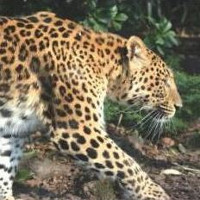 |
Barbary leopard |
|
He is a wild animal |
Origin |
North Africa | |
Translation |
Francis Vandersteen |
| The possession of this animal is not authorized Royal Decree establishing the list of mammals not kept for production purposes that may be kept (M.B. 24.08.2009) |
| The Barbary leopard or Atlas leopard is a leopard that lives in North Africa, in the Atlas mountain range. Now highly endangered and possibly extinct, it is the last large predator in North Africa since the disappearance of the Atlas lion and Atlas bear. It has existed since antiquity, as evidenced by the ancient mosaics found in these regions, although little is known about the animal's history. The Barbary leopard lives mainly in the pine, juniper, cedar and other coniferous forests of the mountainous regions of North Africa. It is a mountain animal, living in colder areas than its cousin, the African leopard. It can be recognized by its thicker coat, which enables it to withstand the cold nights in the mountains. It is a predator that preys on medium-sized prey, such as monkeys, gazelles and sometimes even Barbary deer. Rare photographs of the Barbary leopard exist; in the documentary Sahara Source de Vie, we see a specimen hunting mouflons and magots in Morocco. It is thought to have disappeared into the wild before it could be photographed. Some scientists believe that this is not a distinct subspecies of leopard, but simply the African leopard. However, in the absence of specimens, it is impossible to carry out DNA analyses to verify whether the African leopard and the Barbary leopard are one and the same animal, or two different animals. The Barbary leopard, if it still exists, is now so rare that it has not been possible to study it scientifically. Most of the information we have about it comes from historians, and Roman historians in particular. According to the University of Cambridge and most professionals, the last Berber leopard in the wild was killed in 1926. In fact, the Barbary leopard was still present in the Moroccan Middle Atlas until at least 1972 (a close observation in the scree slopes overlooking the Aguelmane Azigza). A few years ago, however, a team of zoologists found around thirty leopards in the mountains of Morocco and Algeria. |






 English (United Kingdom)
English (United Kingdom)